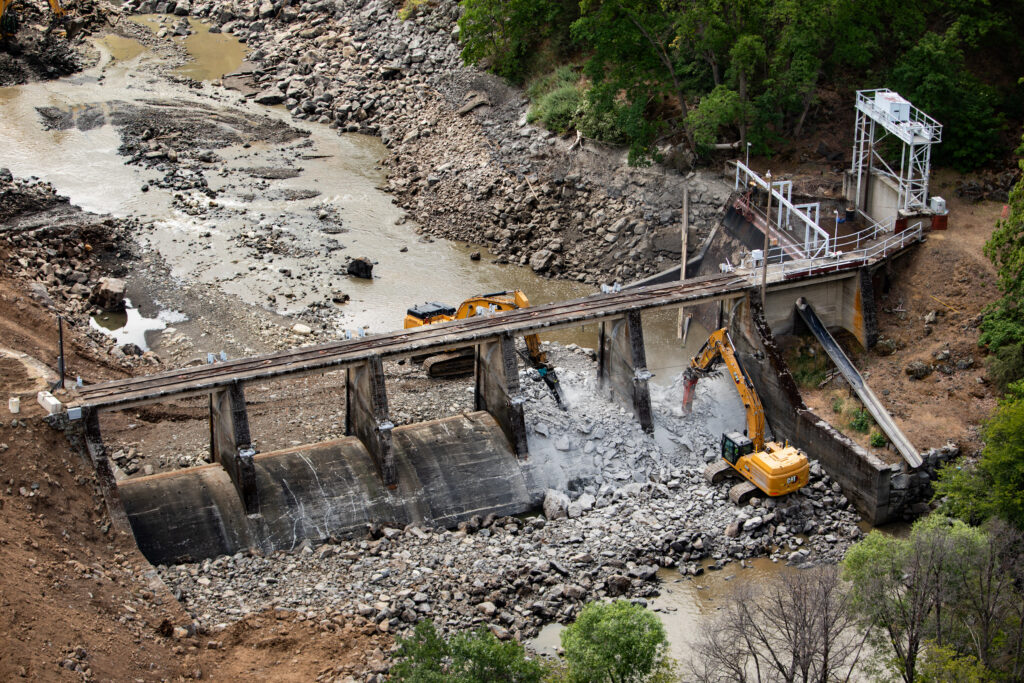
As many have heard by now, 2023 was a major milestone year for dam removal in the U.S., with the initiation of the largest dam removal project in the country on the Klamath River in California. However, you may not have heard about the 79 other dams that were removed, reconnecting 1,160 upstream river miles. These projects reestablished migration corridors, made natural and human communities more resilient to climate change, improved access to habitat to promote biodiversity, eliminated safety hazards and maintenance costs, enhanced access to rivers for local communities, reestablished natural processes for healthy rivers, and many other benefits.
As a nationwide leader in river restoration, American Rivers tracks dam removal trends and maintains a national dam removal database. A total of 2,119 dams have been removed in the U.S. since 1912.
In 2023, the states leading in dam removal were:
Pennsylvania (15 removals)
Oregon (9 removals)
Massachusetts (6 removals)
Twenty-two other states also removed dams in 2023: Arkansas, California, Colorado, Connecticut, Florida, Idaho, Indiana, Kentucky, Maine, Michigan, Minnesota, Montana, New Jersey, New York, Ohio, Tennessee, Texas, Utah, Vermont, Washington, Wisconsin, and Wyoming.
Pennsylvania still leads the country in all time number of dam removals at 390!
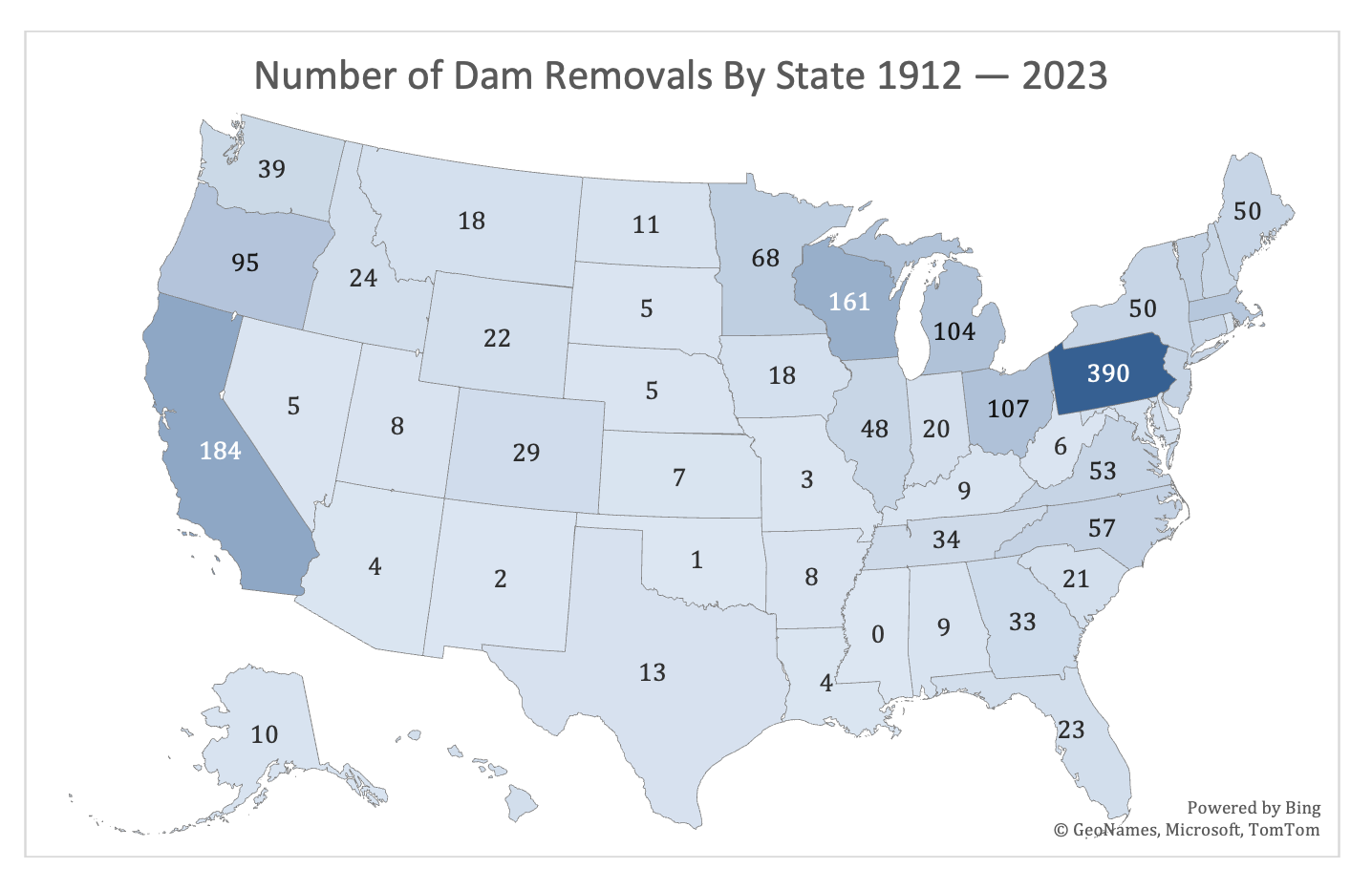
As Katie Schmidt recently shared, the Bipartisan Infrastructure Law has promoted a bump in removals, helping with at least 18 of this past year’s projects. We need more funding like this in order to address the backlog of dilapidated infrastructure out there.
Many dams in the U.S. are no longer serving the purpose for which they were constructed and/or are deteriorating and in need of significant repairs. Dilapidated dams pose safety hazards and threaten the resilience of human and natural communities. This year, the National Low Head Dam Inventory Task Force, in partnership with the Southeast Aquatic Resources Partnership, catalogued hundreds of thousands of dams, bringing the national total to more than 531,000 dams. American Rivers is building a movement to remove 30,000 dams by 2050, in partnership with communities, Tribal Nations, and state and federal agencies, to ensure that rivers can continue to sustain life.
You can read more about some of the projects completed in 2023 in our annual dam removal summary.
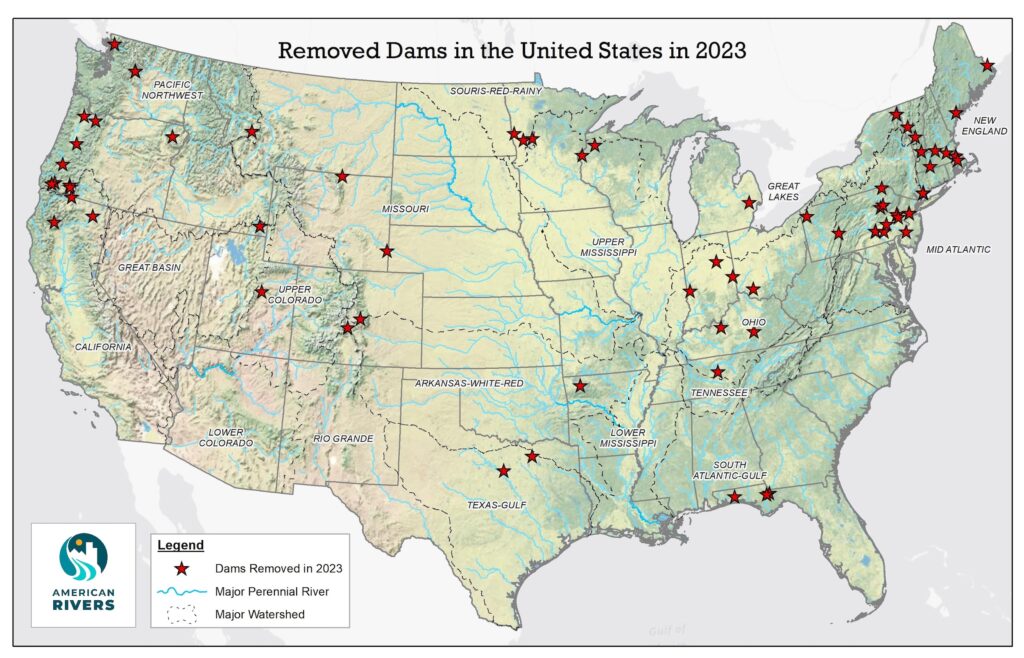
If you work on dam removals in some capacity (practitioner, regulator, researcher, contractor, community advocate, etc.), we invite you to join our National Dam Removal Community of Practice. We will be working with this community to build out strategies to get to 30,000 dam removals by 2050. If you aren’t heavily involved in dam removal, but you still love the idea of it, we would appreciate your financial support to keep the lights on.
Lastly, if you want to hear more about some case studies from the 2023 cohort of dam removals, please consider joining us for a webinar on February 21 at 3PM ET. You can register here.
We can make this happen together!

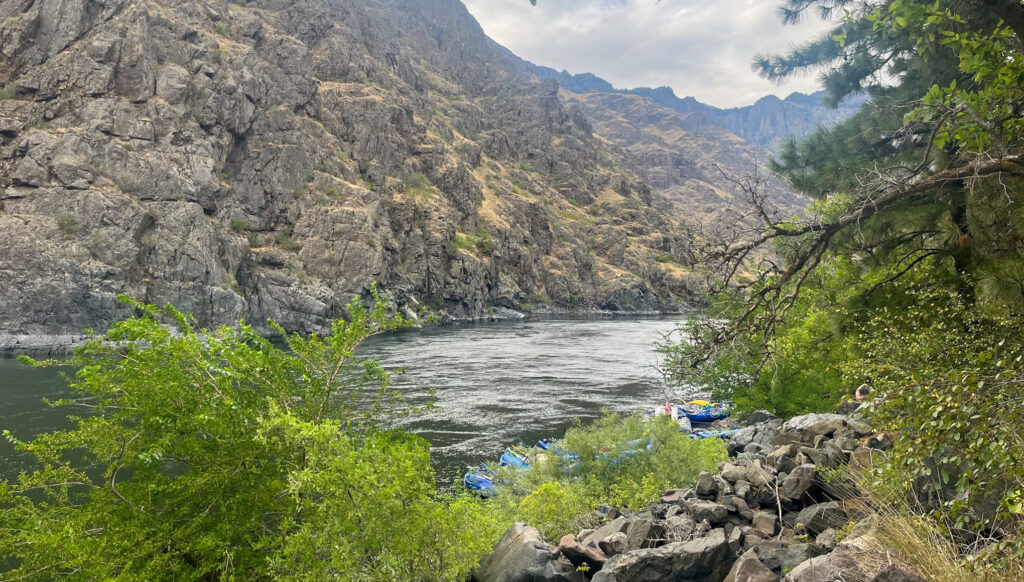
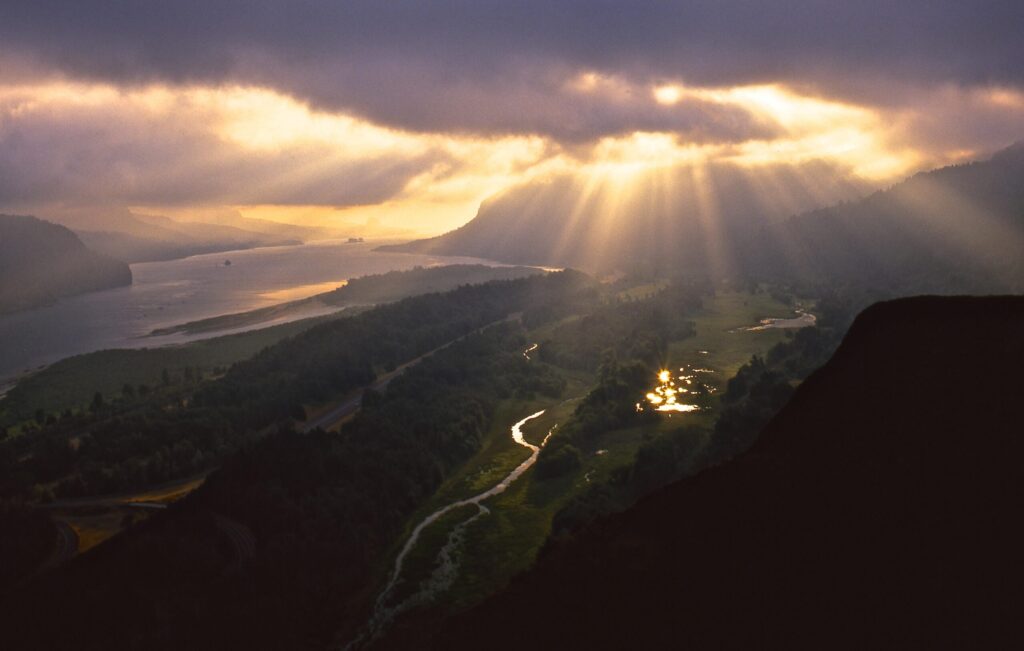
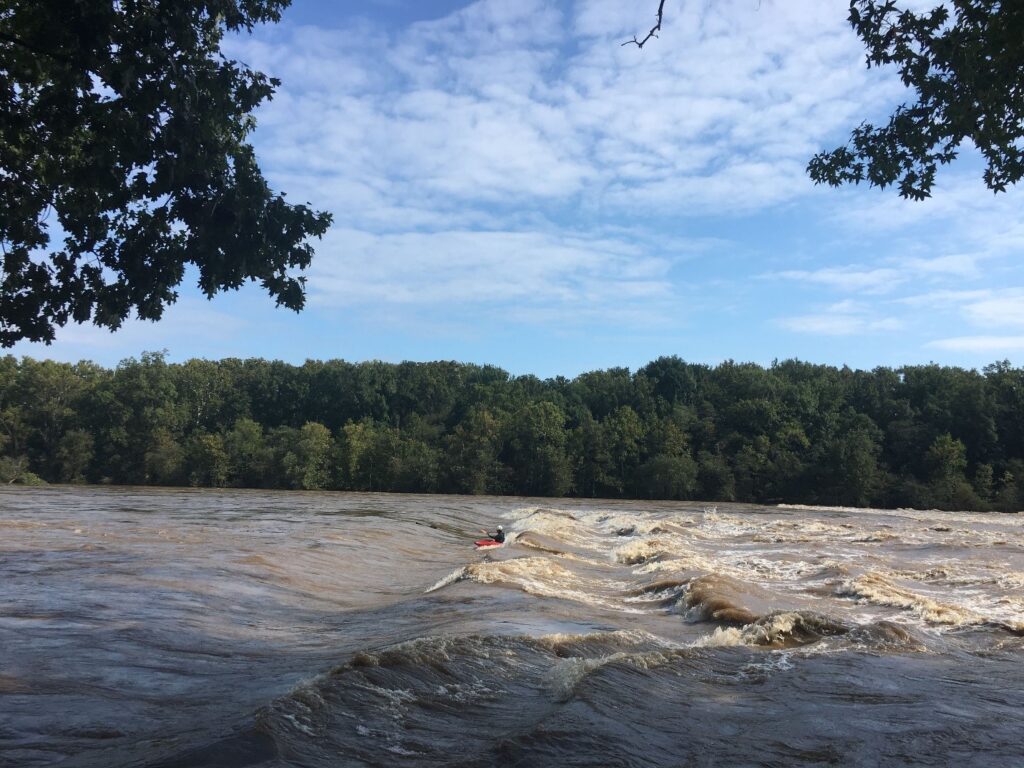
32 responses to “Saying Adios to 80 Dams in 2023”
I noticed the American Rivers dam removal database omits river flow rates, lake volumes, and annual MWhrs lost to dam removal. Generally I believe dams at the end of their design life and poorly designed dams should be removed or not repaired when seriously damaged but the act of removing a dam creates a loss of resources (including wildlife habitat) that should be tracked and understood.
Please focus some of your work on more dam removals in Texas. I paddled the San Marcos River recently and its a beautiful sub tropical spring fed recreactional waterway that is chock full of dangerous (exposed rebar!) and deadly dams that people need to portage around. They don’t even serve a purpose anymore.
I guess some people believe just mosquitos live in the lakes that dams create – Hey – fish eat mosquitos and other bugs and grow to nice catchable size. Yes folks – Fish Thrive in the lakes created by dams – so do people who swim, boat, and eat, and enjoy a smoothie water to float on. Those waters irrigate thousands of acres of food production. Protection of people from flooding when built accordingly and the fish ‘ladders’ never block the best and brightest fish from reaching their spawning place. Salmon are gobbled up by bigger fish in the ocean – hummm – perhaps those caught in the “save mommie earth” mind set, that are passionate about saving fish should consider how to cordon off ocean areas free off salmon eaters!
I understand that everyone has the right to their “opinion” but when it is not connected to theology of human growth as stated in Genesis, or the principal of continuous harmonic development that our universe operates by which “Religion” and “Science” come together for the benefit of everyone, especially known that species come and go continuously, but humans have come to not ‘go’, and can find the means to protect all critters as long as possible then their education and economic means is based on the cognitive LIFE of our universe – people – are the wave of the never-ending future.
Hi, Water is the very essence of life and rivers carry that life. To dam a river is to kill that river and life. We must do everything we can on earth to restore it to the way it was laid down. We are going down the wrong trail and must change course if we are to continue. All life on earth is connected and must be respected. New forms of energy and less energy must be our motto. Money can no longer rule the day. Taking care of Earth must be the law of the land.
It’s great to hear that American rivers are being restored to their pristine states with the removal of old dilapidated dams. It looks like 2023 has been a great year. Let’s keep up the great work. There’s nothing more beautiful and great for nature than clean rivers and streams. Thank you.
Dams are dangerous and destructive. In a matter of time we will experience a major dam failure in earthquake prone California. I’m baffled to think that the feds and state are willing the risk the lives of thousands of people with their dam projects… Never forget the Oroville Dam debacle…
I think missing from the list is the Graue Mill dam on Salt Creek in Oak Brook, IL in 2023. https://oakbrookmagazine.com/a-fond-farewell-to-the-graue-mill-dam/
Hi
i’m italian and sustain that the course of rivers must be remain intact respect to the damages of interruptions dams. Who touch the rvers, die !!!
If we wish save water for our utilize…. this it’s very easy …. when the river is in flood and big ….. we can build a serie lakes artificials siding the river and pump water in this accumulator lake …the lake is shure a great accumulator … the city of London is full ao a intelligent lakes net that garanted survive to 10 million people …. this lakes are impermeables and is filled only with clear water …don’t have any problem – non manutention in the long time…. for move water and decrease algas in the lakes is suffisant bluid a floatant photovoltaic implant woth subwater pump for create funtains.
Sotty for my language & good luck … sorry good lakes !!
In Usa you have bisg space for do many net lakes.
Federico
Collaboration with research fish pass, fish migration and River Restoration in Bangladesh between USA
It’s amazing how many people posting comments on here understand zero about science. Dams are generally quite disruptive to the natural environment. Other than in a few cases where there are serious flooding concerns, dams are simply an outdated approach to water management and power generation. Many of you folks seriously need to consider going back to school and getting a refresher on basic science. Sheesh. Embarrassing.
Please keep up the good work of removing Dams. We need free-flowing water that is cool and natural, not heated dead pools. Dam removals improve fish and wildlife habitat, and restore strong fish runs. The Dams that are being removed no longer serve the purpose they were built for, time to get rid of them.
There is another agenda for removing 80 dams other than saving fish. Get rid of farming? Make more areas to be drought ridden? This makes us all to be dependent on other outside resources for foodto the detriment of our country.
You are correct Kathy. It’s all part of Agenda 21/30. Depopulation.
Does that include Brinkhaven Dam? Mohican River, Ohio. Removed in December.
Please ignore all of the negative comments about dam removal. Keep up the good work on dam removals. It proves to me that we are not without hope as a species.
I have a concern with the removal of so many dams is o understand why they were built in the first place. I suspect the primary reason was to prevent flooding down stream and to create hydro electric power resource.. We still need these resources and how do we as a nation provide them if the resource is no longer available.
Let beavers build dams and lakes if people would just stop killing them.
Long term maybe. Short term everything living in the Klamath is now dead, mud everywhere and it stinks.
It seems like some entire generations will totally sell out the future generations for minimal short-term gain and I got to say I think it’s disgusting. This is a non-profit doing GODS WORK. Entire ecosystems are collapsing due to the myriad pressures being applied to them and the losses that inevitably will be incurred will be not just tragic but expensive. Let’s not kick the can down the road because you don’t like the smell of mud. Try to think of someone other than yourself.
Dennis, by this spring, some of the huge amount of planting along those present-day mud flats will be growing. Some is already sprouting! The planning was long and careful and arduous, and will reap rewards much sooner than you think. Please look into the answers to your questions, instead of throwing out an easy criticism that isn’t even accurate. Maybe, as you watch all the amazing changes occur, and the new look of the land starts to take shape, you will gain a bit of appreciation — and experience something new: Patience with nature and the pace at which it works. Then you may eventually understand the reasons for doing this massive undertaking.
Here’s to lomg term drought making like unlivable in all these places. Reap what you sow.
When will the damon the oklawaha River be removed
The Klamath dam removals in California were done for strictly “environmental” reasons – to return the rivers to their natural state (although they obliterated the natural dams that existed originally, too). They destroyed the electric generation that served 80,000 homes and the wildlife, including fish, deer and birds are dying by the thousands since the dam was removed. Citizens wells are drying up and the small ag industry up there is being driven out. All this, for what again??
Stop Removing the Dams
The American southwest from California to Texas is in a perpetual state of drought due to over population and lack of infrastructure. How are we going to support the ever growing population of these areas without dams and reservoirs? The United States produces 20% of the worlds food supply. California is number one and Texas is number three. Both states facing historic and perpetual droughts. Both states have access to desalination but have not been able to supplement the water supply do to environmental concerns. So what do we die of thirst or adapt our environments to ensure our survival?
You’re making problems that were solved years ago .to depend on wind and solar for electricity require ten time the amount of land. Where’s that rationale. After dam removals what you have is a mall trickle of water,nobody benefits except some and only some fish. Alot of people just want to tear America down! This simply delights them.costly waste of resources.
Ridiculous to remove these dams unless they are seriously going to fail. Why not improve them instead? This is taking away so many reservoirs! So sad.
Please before you get carried away w your dam removal share your plan for replacing the electricity provided by many of the dams as well as late summer irrigation for crops, spring time flood control, year around transportation of “goods”, easy access for recreation, the list is long and with the population being what it is today, this country cannot afford to loose what the dams provide. If we want to go back to everything natural, perhaps we should tear up our paved roads, give up our vehicles, everyone go back to the horse and buggy, stop covering up farm ground w housing and industrial businesses, makes as much sense as taking out the dams. There has to be an ulterior motive here, salmon can be fished for in a lot of areas, purchased in restaurants and at markets, fishing for them is the recreation of a minimum number of citizens in the United States, especially the North Western United States!
I’m curious to know how you define ‘dam.’ I’ve floated thousands of miles of rivers in every western state except Hawaii, and on smaller rivers like the White, upper Green, etc. there are dozens of diversion weirs (to back up water into irrigation canals for hay, mostly) and in some areas such as the White River above Meeker, simply to create trout habitat for wealthy fly fishermen. (Ironically, these attempt to replicate what beaver would have made if they hadn’t been eradicated.) Some water passes through, there is often a passage that smaller inflatables can run through… but not always.
The public probably thinks of large earthen or concrete structures designed for power generation and/or water storage when they see or hear ‘dam.’ I’m guessing your definition is something like ‘any man-made object in a river that obstructs or diverts the natural flow.’ Clarity on just what you mean by ‘dam’ would perhaps lead to people re-thinking the task. For example, do the ‘trout Disneyland’ weirs along the upper White, spanning the river dozens of times on privately owned land, even need a permit? Are they legal? What about the irrigation diversions? What if such diversions are abandoned, but still dangerously obstructing the river, as with Diversion Dam Rapid on the Dolores?
Thanks for what you do,
Bryan Burke
No dames ,no water to grow food going to be a big food shortage, grain hay ,grass ,
Your nuts. We need dam’s